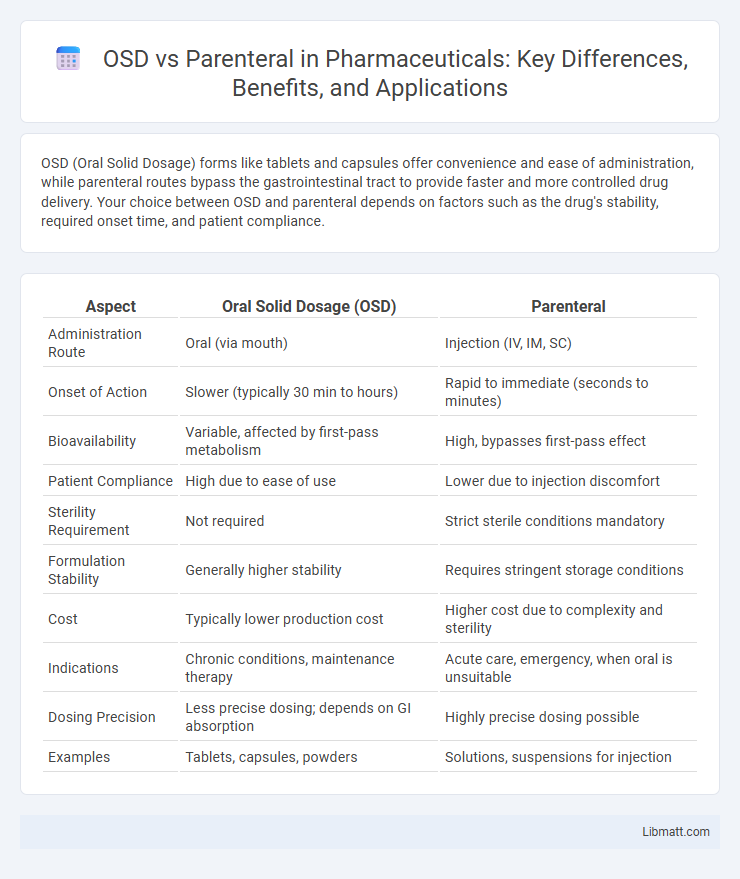OSD (Oral Solid Dosage) forms like tablets and capsules offer convenience and ease of administration, while parenteral routes bypass the gastrointestinal tract to provide faster and more controlled drug delivery. Your choice between OSD and parenteral depends on factors such as the drug's stability, required onset time, and patient compliance.
Table of Comparison
| Aspect | Oral Solid Dosage (OSD) | Parenteral |
|---|---|---|
| Administration Route | Oral (via mouth) | Injection (IV, IM, SC) |
| Onset of Action | Slower (typically 30 min to hours) | Rapid to immediate (seconds to minutes) |
| Bioavailability | Variable, affected by first-pass metabolism | High, bypasses first-pass effect |
| Patient Compliance | High due to ease of use | Lower due to injection discomfort |
| Sterility Requirement | Not required | Strict sterile conditions mandatory |
| Formulation Stability | Generally higher stability | Requires stringent storage conditions |
| Cost | Typically lower production cost | Higher cost due to complexity and sterility |
| Indications | Chronic conditions, maintenance therapy | Acute care, emergency, when oral is unsuitable |
| Dosing Precision | Less precise dosing; depends on GI absorption | Highly precise dosing possible |
| Examples | Tablets, capsules, powders | Solutions, suspensions for injection |
Introduction to OSD and Parenteral Drug Delivery
Orally Solid Dosage (OSD) forms, including tablets and capsules, offer convenience, ease of administration, and patient compliance through gastrointestinal absorption. Parenteral drug delivery bypasses the digestive system by administering medications via injections, ensuring rapid onset of action and precise bioavailability. Your choice between OSD and parenteral methods depends on factors like drug properties, required onset time, and patient condition.
Definition and Overview of OSD (Oral Solid Dosage)
OSD (Oral Solid Dosage) refers to pharmaceutical formulations such as tablets, capsules, and powders designed for oral administration, offering convenience and precise dosing. Parenteral administration involves delivering drugs through injections or infusions, bypassing the gastrointestinal tract for rapid systemic effect. Your choice between OSD and parenteral depends on factors like drug stability, onset of action, and patient compliance.
Definition and Overview of Parenteral Drug Delivery
Parenteral drug delivery involves administering medications by injection through routes such as intravenous, intramuscular, or subcutaneous, bypassing the digestive system for rapid absorption and precise dosing. Unlike oral solid dosage (OSD) forms, which require gastrointestinal processing, parenteral methods provide immediate bioavailability, essential for patients needing urgent or controlled drug effects. Your choice between OSD and parenteral routes depends on factors like drug stability, patient condition, and desired onset of action.
Key Differences Between OSD and Parenteral Routes
Oral Solid Dosage (OSD) and parenteral routes differ primarily in administration method, with OSD involving oral ingestion of tablets or capsules, while parenteral routes include injections such as intravenous, intramuscular, or subcutaneous delivery. OSD offers convenience and patient compliance but faces challenges like variable absorption and first-pass metabolism, whereas parenteral administration ensures rapid bioavailability and precise dosing by bypassing the gastrointestinal tract. Safety profiles vary significantly; parenteral routes carry higher risks of infection and require sterile techniques, unlike OSD formulations.
Advantages of OSD Formulations
Oral solid dosage (OSD) formulations offer significant advantages such as ease of administration, improved patient compliance, and cost-effectiveness compared to parenteral routes. These formulations enable precise dose control and prolonged stability, reducing the risk of contamination and enhancing shelf life. Improved convenience and non-invasive delivery make OSDs preferable for chronic therapies and outpatient treatment settings.
Benefits of Parenteral Drug Administration
Parenteral drug administration provides rapid and complete bioavailability, bypassing the gastrointestinal tract and first-pass metabolism, which ensures faster therapeutic effects compared to oral solid dosage (OSD) forms. This route is particularly beneficial for drugs that are poorly absorbed orally, unstable in the digestive environment, or require immediate onset of action. Parenteral methods also allow precise control over drug dosing and are essential for patients who cannot swallow or have impaired gastrointestinal function.
Limitations of OSD vs Parenteral Routes
Limitations of oral solid dosage (OSD) forms include variable bioavailability due to first-pass metabolism and gastrointestinal factors, which can reduce drug efficacy compared to parenteral routes. Parenteral administration bypasses the digestive system, allowing for rapid and complete drug absorption, essential for critical or emergency treatments. Your choice between OSD and parenteral routes depends on factors such as patient condition, required speed of action, and drug properties affecting absorption.
Clinical Applications: When to Choose OSD or Parenteral
Oral solid dosage (OSD) forms are ideal for chronic conditions requiring convenient, self-administered therapy with good patient compliance, such as hypertension or diabetes. Parenteral administration is preferred for emergencies, severe infections, or when rapid onset and precise bioavailability are critical, like in septic shock or chemotherapy. Your choice depends on clinical urgency, absorption issues, and patient-specific factors influencing therapeutic outcomes.
Safety and Compliance Considerations
Oral solid dosage (OSD) forms generally offer enhanced patient compliance due to ease of administration and reduced need for healthcare provider involvement, minimizing risks of administration errors. Parenteral routes, while ensuring rapid and complete bioavailability, pose higher safety concerns including infection risks, need for sterile technique, and potential for injection site complications. Adherence monitoring is more straightforward with OSD, whereas parenteral therapies require strict clinical supervision to maintain safety and proper dosing compliance.
Future Trends in OSD and Parenteral Drug Development
Emerging trends in Oral Solid Dosage (OSD) formulations emphasize enhanced bioavailability through advanced nanoparticle technologies and targeted drug delivery systems, reducing dosing frequency and improving patient adherence. Parenteral drug development is shifting towards long-acting injectables and biodegradable implants that provide sustained release, minimizing hospital visits and enhancing therapeutic outcomes. Your treatment options will increasingly benefit from these innovations, offering more personalized and efficient medication regimens.
OSD vs Parenteral Infographic

 libmatt.com
libmatt.com